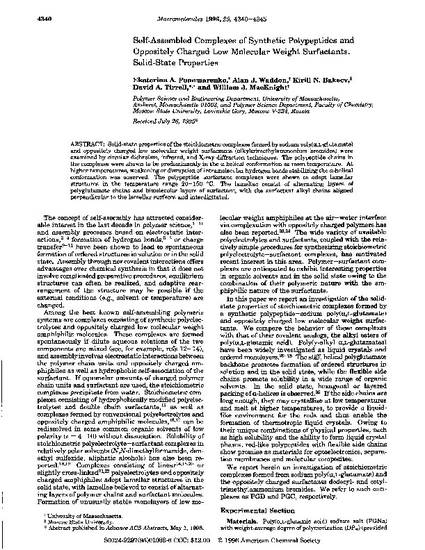
Article
Self-Assembled Complexes of Synthetic Polypeptides and Oppositely Charged Low Molecular Weight Surfactants. Solid-State Properties
Macromolecules
(1996)
Abstract
Solid-state properties of the stoichiometric complexes formed by sodium poly(a,L-glutamate)
and oppositely charged low molecular weight surfactants (alkyltrimethylammonium bromides) were
examined by circular dichroism, infrared, and X-ray diffraction techniques. The polypeptide chains in
the complexes were shown to be predominantly in the a-helical conformation at room temperature. At
higher temperatures, weakening or disruption of intramolecular hydrogen bonds stabilizing the a-helical
conformation was observed. The polypeptide-surfactant complexes were shown to adopt lamellar
structures in the temperature range 20-150 °C. The lamellae consist of alternating layers of
polyglutamate chains and bimolecular layers of surfactant, with the surfactant alkyl chains aligned
perpendicular to the lamellar surfaces and interdigitated.
Keywords
- Self-Assembled Complexes,
- Synthetic Polypeptides,
- Oppositely Charged,
- Low Molecular Weight Surfactants,
- Solid-State Properties
Disciplines
Publication Date
1996
Citation Information
William MacKnight, Ekaterina A. Ponomarenko, Alan J. Waddon, Kirill N. Bakeev, et al.. "Self-Assembled Complexes of Synthetic Polypeptides and Oppositely Charged Low Molecular Weight Surfactants. Solid-State Properties" Macromolecules Iss. 29 (1996) p. 4340 - 4345 Available at: http://works.bepress.com/william_macknight/258/
